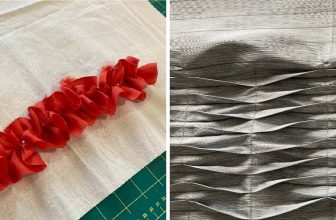How to Store Fabric
Properly storing fabric is essential to maintain its quality, prevent damage, and keep your fabric collection organized. Whether you’re a sewing enthusiast, quilter, or craft lover, knowing to store fabric effectively will ensure that your materials stay in excellent condition and are easily accessible for future projects. In this article, we will explore various tips and techniques on how to store fabric properly.

From choosing the right storage containers to implementing space-saving solutions, we will provide you with valuable insights to help you create a functional and tidy fabric storage system. Whether you have a small collection or a vast assortment of fabrics, get ready to learn the best practices for storing fabric and ensure that your materials remain in perfect condition for all your creative endeavors.
What Is the Best Way to Store Cotton Fabric?
Cotton fabrics should be stored in a cool, dry place away from direct sunlight and moisture. Storing cotton fabric in an airtight container or sealed plastic bag will help to protect it from dust, dirt and other debris. The container should allow for some air circulation but keep out pests like moths and mice. It’s also important to store fabrics on shelves or hangers that won’t cause the material to become creased or wrinkled when folded over them.
Wrapping the fabric around acid-free tissue paper can also help prevent discoloration due to oxidation. Finally, use mothballs according to the product instructions if you are concerned about pests damaging your fabric while in storage. With proper care and storage, cotton fabrics can last a long time and stay looking good.
In addition to storing cotton fabrics properly, it is important to regularly check the fabric for signs of wear and tear. If any damage is found, it should be treated as soon as possible to prevent further deterioration or discoloration.
Finally, remember not to store the fabric in a humid or damp environment which can cause mildew and other problems. With proper care and storage, your cotton fabrics will retain their beauty for years to come.
10 Methods How to Store Fabric
1. Sort and Categorize
Start by sorting your fabric collection into categories such as color, fabric type, or project theme. This will make it easier to locate specific fabrics when needed. If you’re feeling really organized, create labels with the fabric type and color.

However, if you feel overwhelmed at the thought of categorizing, just start by sorting fabrics into light and dark piles. Although, this may take more time when looking for a particular fabric.
2. Fold Neatly
Fold each piece of fabric neatly to minimize creases and wrinkles. Aim for uniformity in size, such as folding fabrics into squares or rectangles. This not only saves space but also allows for easier stacking and organization.
Depending on the fabric, it may be necessary to use tissue paper or acid-free paper in between folds. This will help reduce wear and tear from the fabric rubbing against itself. Additionally, it is important to label each folded piece of fabric with its content for quick identification later on.
3. Use Acid-Free Tissue Paper
To prevent yellowing or discoloration, place acid-free tissue paper between folded fabric layers. This will help maintain the fabric’s quality and protect it from exposure to light and dust. Additionally, use cedar chips or other natural insect repellents to deter moths.
Although mothballs can do the job, they release toxic fumes that could damage your fabric. Make sure to store all fabrics in a cool, dry place away from direct sunlight. Through care and preparation, you can store your fabric for extended periods of time without any damage or discoloration.
4. Utilize Clear Plastic Bins or Containers
Opt for clear plastic bins or containers to store your fabric. This allows you to easily see the contents without having to open each container. Ensure the bins are sturdy and stackable for efficient use of space.
Label each bin with a description of the contents, so you can easily search for what you need. Place heavier and less used fabrics on the bottom and lighter, more frequently used fabrics on the top. If desired, line the interior of the plastic containers with acid-free tissue paper to protect your fabrics. This will also help absorb moisture and discourage mold growth.

5. Label Your Storage Containers
Label each storage container with the category or type of fabric it contains. This makes it convenient to locate specific fabrics and keeps your collection organized. For example, you might label one box “Quilting Cotton,” another “Silk Dupioni,” and so on. This is especially useful if you have a large selection of fabrics and colors.
Additionally, if your containers are clear, you can further label them with the color of the fabric it contains. Doing so will save you the time of having to look through each box, and you’ll be able to quickly assess what fabrics you have available for a specific project.
6. Store in a Dark and Dry Area
Choose a storage space away from direct sunlight, as it can cause fading or discoloration over time. Additionally, ensure the area is dry to prevent mold or mildew growth on your fabrics. If storing in a basement or attic, use airtight containers to combat humidity.
For long-term fabric storage, consider using mothballs or cedar chips to deter moths and other insects. Finally, rotate fabrics from time to time for more even wear. This will help extend the life of your fabric collection.
7. Avoid Excessive Heat and Humidity
Extreme temperatures, high humidity, and fluctuating conditions can damage the fabric. Store your fabrics in an area with a stable and moderate climate to maintain their quality. If the area is prone to high humidity, consider using a dehumidifier.
Also, ensure that the fabric is away from any source of heat, such as radiators, direct sunlight, and hot water pipes. In general, fabrics should be stored in a cool, dry place away from bright lights and heat sources.
8. Hang Larger Pieces
For larger pieces of fabric, such as bolts or rolls, consider hanging them on sturdy garment racks or using specially designed fabric storage systems. This helps prevent excessive folding or creasing. If you’re using a garment rack, make sure it is strong and stable enough to hold the fabric without tipping over.
The same goes for fabric storage systems—look for one that’s designed to store heavy materials. Use empty hangers or clips to hang the fabric on the rack for easy access. Be sure to label each piece clearly so you can find it easily when needed.

9. Utilize Shelving Units or Cubbies
Invest in shelving units or cubbies to store your folded fabrics. This allows for easy visibility and accessibility, particularly for smaller fabric pieces or remnants. If you have enough space, consider stacking the shelves or cubbies vertically this way, you can maximize your storage area and free up floor space. Label the shelves or cubbies by color, type of fabric, or other categories that make sense to you.
10. Rotate Your Fabrics
To prevent fabric deterioration or weakening due to prolonged storage, periodically rotate your fabrics. Bring older fabrics to the front and use them in your projects, ensuring that your entire collection gets regular use.
As part of a regular rotation, you can also periodically check for any damage or discoloration that could be caused by prolonged storage in the same place and adjust your storage solutions accordingly. This will help you keep fabrics in the best condition possible, regardless of how long they’ve been stored.
Some Common Mistakes When Storing Fabrics
1. Not Cleaning Fabrics Before Storage:
Before storing any fabric, it is important to make sure any residue or dirt has been removed. This will help to preserve the fabric and prevent dirt from transferring onto other fabrics.
2. Storing Fabrics in Plastic Bags:
Avoid storing fabric in plastic bags as they can attract moisture and promote mildew growth. Instead, opt for breathable storage containers or paper bags, which will allow air to circulate and help keep the fabric dry.
3. Not Labeling Fabrics:
It is important to label each piece of fabric, as this will make it easier to find when you need it. Not only that, but labeling also helps prevent accidental discarding or misplacing of fabrics.

Conclusion
In summary, learning how to store fabric is an important step when it comes to proper fabric care and maintenance. From choosing the right storage containers and packing materials to carefully folding your fabric, there are numerous steps that can be taken to ensure your fabric is properly stored and preserved.
That said, it’s important to remember that different types of fabrics should be treated differently; what works for one fabric may not necessarily apply for another.
Do your research to determine what works best for the particular type of fabric you’re dealing with and always double check proper storage methods when needed. If done correctly, storing your fabric should take little effort – so don’t hesitate any longer: get organized and start storing fabric properly today!




